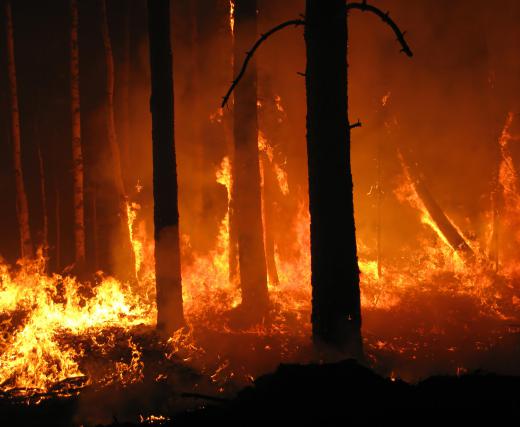A conflagration is, in simplest terms, an uncontrolled and destructive fire, particularly one that threatens human concerns such as health or property or natural concerns such as forests or wildlife. Such a fire can be caused by any of the many possible sources of fire and can be of just about any scale. A conflagration is primarily defined by its destructive and uncontrolled nature, not by its size or origin. A fire in a warehouse that destroys inventory and a forest fire could both be considered conflagrations, while a candle flame and a campfire could not. Businesses, homeowners, and others can take a variety of preventative measures to avoid conflagrations and to minimize damage caused should one occur.
It is possible for a conflagration to start in a variety of ways. A lightning strike, for instance, is a possible natural cause of an uncontrolled fire. Fires can be started accidentally through poor electrical wiring, neglect of objects on a hot stove, careless discarding of a burning cigarette, or any of a vast variety of other ways. One might also start a conflagration intentionally as a direct attack on another person through his property or through uncontrolled psychological impulses. Uncontrolled impulses to intentionally start fires, destructive or otherwise, are referred to as pyromania.

A conflagration, particularly a large one, can become quite dangerous, largely because of the movement of air that it can cause. A fire tends to sent hot air upward, thereby causing surrounding air to rush into the area of the fire. This influx of air provides plenty of oxygen to the fire, causing it to grow and spread very rapidly if sufficient fuel is available to allow it to do so. This phenomenon is sometimes referred to as a firestorm. The conflagration becomes largely self-sustaining because, as long as it has sufficient fuel, it will be able to provide itself with a sufficient air supply.

Architects, building managers, and various other experts often take great pains to avoid potential damage from conflagrations, particularly when human lives or valuable inventories are at risk. Elaborate sprinkler systems can be designed to allow people time to escape a building before the conflagration reaches them or to thoroughly douse an inventory with fire retardant, preventing as much damage as possible. Fire doors and other fire-resistant building components are included in many building designs in order to restrict a conflagration to a particular part of a building or, at the very least, to slow its spread.
